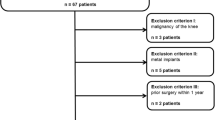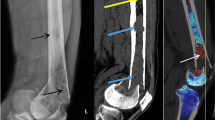Abstract
Objective
To evaluate the feasibility of producing 2-dimensional (2D) virtual noncontrast images and 3-dimensional (3D) bone models from dual-energy computed tomography (DECT) arthrograms and to determine whether this is best accomplished using 190 keV virtual monoenergetic images (VMI) or virtual unenhanced (VUE) images.
Materials and methods
VMI and VUE images were retrospectively reconstructed from patients with internal derangement of the shoulder or knee joint who underwent DECT arthrography between September 2017 and August 2019. A region of interest was placed in the area of brightest contrast, and the mean attenuation (in Hounsfield units [HUs]) was recorded. Two blinded musculoskeletal radiologists qualitatively graded the 2D images and 3D models using scores ranging from 0 to 3 (0 considered optimal).
Results
Twenty-six patients (mean age ± SD, 57.5 ± 16.8 years; 6 women) were included in the study. The contrast attenuation on VUE images (overall mean ± SD, 10.5 ± 16.4 HU; knee, 19.3 ± 10.7 HU; shoulder, 5.0 ± 17.2 HU) was significantly lower (p < 0.001 for all comparisons) than on VMI (overall mean ± SD, 107.7 ± 43.8 HU; knee, 104.6 ± 31.1 HU; shoulder, 109.6 ± 51.0 HU). The proportion of cases with optimal scores (0 or 1) was significantly higher with VUE than with VMI for both 2D and 3D images (p < 0.001).
Conclusions
DECT arthrography can be used to produce 2D virtual noncontrast images and to generate 3D bone models. The VUE technique is superior to VMI in producing virtual noncontrast images.







Similar content being viewed by others
References
Lestra T, Mule S, Millet I, Carsin-Vu A, Taourel P, Hoeffel C. Applications of dual energy computed tomography in abdominal imaging. Diagn Interv Imaging. 2016;97(6):593–603.
Mileto A, Marin D, Nelson RC, Ascenti G, Boll DT. Dual energy MDCT assessment of renal lesions: an overview. Eur Radiol. 2014;24(2):353–62.
Slebocki K, Kraus B, Chang DH, Hellmich M, Maintz D, Bangard C. Incidental findings in abdominal dual-energy computed tomography: correlation between true noncontrast and virtual noncontrast images considering renal and liver cysts and adrenal masses. J Comput Assist Tomogr. 2017;41(2):294–7.
Wichmann JL, Gillott MR, De Cecco CN, et al. Dual-energy computed tomography angiography of the lower extremity runoff: impact of noise-optimized virtual monochromatic imaging on image quality and diagnostic accuracy. Investig Radiol. 2016;51(2):139–46.
Park SY, Kim CK, Park BK. Dual-energy CT in assessing therapeutic response to radiofrequency ablation of renal cell carcinomas. Eur J Radiol. 2014;83(2):e73–9.
Yamada Y, Jinzaki M, Tanami Y, Abe T, Kuribayashi S. Virtual monochomratic spectral imaging for the evaluation of hypovascular hepatic metastases: the optimal monochromatic level with fast kilovoltage switching dual-energy computed tomography. Investig Radiol. 2012;47(5):292–8.
Marin D, Nelson RC, Barnhart H, et al. Detection of pancreatic tumors, image quality, and radiation dose during the pancreatic parenchymal phase: effect of a low-tube-voltage, high-tube-current CT technique – preliminary results. Radiology. 2010;256(2):450–9.
McNamara MM, Little MD, Alexander LF, Carroll LV, Beasley TM, Morgan DE. Multireader evaluation of lesion conspicuity in small pancreatic adenocarcinomas: complimentary value of iodine material density and low keV simulated monoenergetic images using multiphasic rapid kVp-switching dual energy CT. Abdom Imaging. 2015;40(5):1230–40.
Graser A, Johnson TR, Hecht EM, et al. Dual-energy CT in patients suspected of having renal masses: can virtual nonenhanced images replace true nonenhanced images? Radiology. 2009;252(2):433–40.
Shuman WP, Green DE, Busey JM, et al. Dual-energy liver CT: effect of monochromatic imaging on lesion detection, conspicuity, and contrast-to-noise ratio of hypervascular lesions on late arterial phase. AJR Am J Roentgenol. 2014;203(3):601–6.
Yu L, Leng S, McCollough CH. Dual-energy CT-based monochromatic imaging. AJR Am J Roentgenol. 2012;199(5 suppl):S9–15.
Bodanapally UK, Dreizin D, Issa G, Archer-Arroyo KL, Sudini K, Fleiter TR. Dual-energy CT in enhancing subdural effusions that masquerade as subdural hematomas: diagnosis with virtual high-monochromatic (190-keV) images. AJNR Am J Neuroradiol. 2017;38(10):1946–52.
Bodanapally UK, Shanmuganathan K, Issa G, et al. Dual-energy CT in hemorrhagic progression of cerebral contusion: overestimation of hematoma volumes on standard 120-kV images and rectification with virtual high-energy monochromatic images after contrast-enhanced whole-body imaging. AJNR Am J Neuroradiol. 2018;39(4):658–62.
Bodanapally UK, Archer-Arroyo KL, Dreizin D, et al. Dual-energy computed tomography imaging of head: virtual high-energy monochromatic (190 keV) images are more reliable than standard 120 kV images for detecting traumatic intracranial hemorrhages. J Neurotrauma. 2019;36(8):1375–81.
Chai JW, Choi JA, Choi JY, Kim S, Hong SH, Kang HS. Visualization of joint and bone using dual-energy CT arthrography with contrast subtraction: in vitro feasibility study using porcine joints. Skelet Radiol. 2014;43(5):673–8.
Davenport MS, Neville AM, Ellis JH, Cohan RH, Chaudhry HS, Leder RA. Diagnosis of renal angiomyolipima with Hounsfield unit thresholds: effect of size of region of interest and nephrographic phase imaging. Radiology. 2011;260(1):158–65.
Lin YM, Chiou YY, Wu MH, Huang SS, Shen SH. Attenuation values of renal parenchyma in virtual noncontrast images acquired from multiphase renal dual-energy CT: comparison with standard noncontrast CT. Eur J Radiol. 2018;101:103–10.
Numburi UD, Schoenhagen P, Flamm SD, et al. Feasibility of dual-energy CT in the arterial phase: imaging after endovascular aortic repair. AJR Am J Roentgenol. 2010;195(2):486–93.
Sommer WH, Graser A, Becker CR, et al. Image quality of virtual noncontrast images derived from dual-energy CT angiography after endovascular aneurysm repair. J Vasc Interv Radiol. 2010;21(3):315–21.
Pomerantz SR, Kamalian S, Zhang D, et al. Virtual monochromatic reconstruction of dual-energy unenhanced head CT at 65-75 keV maximizes image quality compared with conventional polychromatic CT. Radiology. 2013;266(1):318–25.
Wellenberg RHH, Donders JCE, Kloen P, et al. Exploring metal artifact reduction using dual-energy CT with pre-metal and post-metal implant cadaver comparison: are implant specific protocols needed? Skelet Radiol. 2018;47(6):839–45.
Wellenberg RH, Boomsma MF, van Osch JA, et al. Quantifying metal artefact reduction using virtual monochromatic dual-layer detector spectral CT imaging in unilateral and bilateral total hip prostheses. Eur J Radiol. 2017;88:61–70.
Jeong J, Kim HJ, Oh E, et al. Visibility of bony structures around hip prostheses in dual-energy CT: with or without metal artefact reduction software. J Med Imaging Radiat Oncol. 2018;62(5):634–41.
Llopis E, Fernandez E, Cerezal L. MR and CT arthrography of the hip. Semin Musculoskelet Radiol. 2012;16(1):42–56.
Acid S, Le Corroller T, Aswad R, Pauly V, Champsaur P. Preoperative imaging of anterior shoulder instability: diagnostic effectiveness of MDCT arthrography and comparison with MR arthrography and arthroscopy. AJR Am J Roentgenol. 2012;198(3):661–7.
Jarraya M, Roemer FW, Gale HI, Landreau P, D’Hooghe P, Guermazi A. MR-arthrography and CT-arthrography in sports-related glenolabral injuries: a matched descriptive illustration. Insights Imaging. 2016;7(2):167–77.
Farber JM. CT arthrography and postoperative musculoskeletal imaging with multichannel computed tomography. Semin Musculoskelet Radiol. 2004;8(2):157–66.
Foti G, Mantovani W, Catania M, et al. Evaluation of glenoid labral tear: comparison between dual-energy CT arthrography and MR arthrography of the shoulder. Radiol Med. 2020;125(1):39–47.
Magee T. Imaging of the post-operative shoulder: does injection of iodinated contrast in addition to MR contrast during arthrography improve diagnostic accuracy and patient throughput? Skelet Radiol. 2018;47(9):1253–61.
De Filippo M, Pesce A, Barile A, et al. Imaging of postoperative shoulder instability. Musculoskelet Surg. 2017;101(suppl 1):15–22.
Oh JH, Kim JY, Choi JA, Kim WS. Effectiveness of multidetector computed tomography arthrography for the diagnosis of shoulder pathology: comparison with magnetic resonance imaging with arthroscopic correlation. J Shoulder Elb Surg. 2010;19(1):14–20.
Mallinson PI, Coupal TM, McLaughlin PD, Nicolaou S, Munk PL, Ouellette HA. Dual-energy CT for the musculoskeletal system. Radiology. 2016;281(3):690–707.
Henzler T, Fink C, Schoenber SO, Schoepf UJ. Dual-energy CT: radiation dose aspects. AJR Am J Roentgenol. 2012;199(5 suppl):S16–25.
Schenzle JC, Sommer WH, Neumaier K, et al. Dual energy CT of the chest: how about the dose? Investig Radiol. 2010;45(6):347–53.
Purysko AS, Primak AN, Baker ME, et al. Comparison of radiation dose and image quality from single-energy and dual-energy CT examinations in the same patients screened for hepatocellular carcinoma. Clin Radiol. 2014;69(12):e538–44.
Jepperson MA, Cernigliaro JG. Ibrahim el-SH, Morin RL, Haley WE, Thiel DD. In vivo comparison of radiation exposure of dual-energy CT versus low-dose CT versus standard CT for imaging urinary calculi. J Endourol. 2015;29(2):141–6.
Uhrig M, Simons D, Kachelrieß M, Pisana F, Kuchenbecker S, Schlemmer HP. Advanced abdominal imaging with dual energy CT is feasible without increasing radiation dose. Cancer Imaging. 2016;16(1):15.
Duan X, Ananthakrishnan L, Guild JB, Xi Y, Rajiah P. Radiation doses and image quality of abdominal CT scans at different patient sizes using spectral detector CT scanner: a phantom and clinical study. Abdom Radiol (NY). 2019 Oct 5; [Epub ahead of print].
Wortman JR, Shyu JY, Dileo J, Uyeda JW, Sodickson AD. Dual-energy CT for routine imaging of the abdomen and pelvis: radiation dose and image quality. Emerg Radiol. 2020;27(1):45–50.
Omoumi P, Becce F, Racine D, Ott JG, Andreisek G, Verdun FR. Dual-energy CT: basic principles, technical approaches, and applications in musculoskeletal imaging (part 1). Semin Musculoskelet Radiol. 2015;19(5):431–7.
Biswas D, Bible JE, Bohan M, Simpson AK, Whang PG, Grauer JN. Radiation exposure from musculoskeletal computerized tomographic scans. J Bone Joint Surg Am. 2009;91(8):1882–9.
Takahashi N, Vrtiska TJ, Kawashima A, et al. Detectability of urinary stones on virtual nonenhanced images generated at pyelographic-phase dual-energy CT. Radiology. 2010;256(1):184–90.
Author information
Authors and Affiliations
Corresponding author
Ethics declarations
Conflict of interest
Naveen Subhas, MD, MPH, has received research support from Siemens Healthcare and NIH. Andrew Primak, PhD, is an employee of Siemens Medical Solutions.
Ethical approval
This retrospective study was approved by the institutional review board with a waiver of informed consent. All procedures performed in studies involving human participants were in accordance with the ethical standards of the institutional and/or national research committee and with the 1964 Helsinki Declaration and its later amendments or comparable ethical standards.
Additional information
Publisher’s note
Springer Nature remains neutral with regard to jurisdictional claims in published maps and institutional affiliations.
Rights and permissions
About this article
Cite this article
Sandhu, R., Aslan, M., Obuchowski, N. et al. Dual-energy CT arthrography: a feasibility study. Skeletal Radiol 50, 693–703 (2021). https://doi.org/10.1007/s00256-020-03603-9
Received:
Revised:
Accepted:
Published:
Issue Date:
DOI: https://doi.org/10.1007/s00256-020-03603-9




